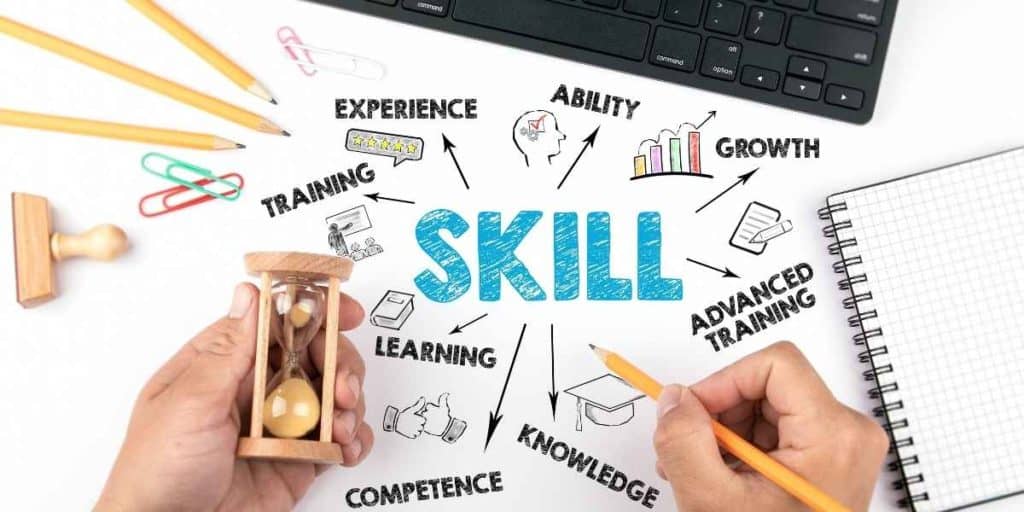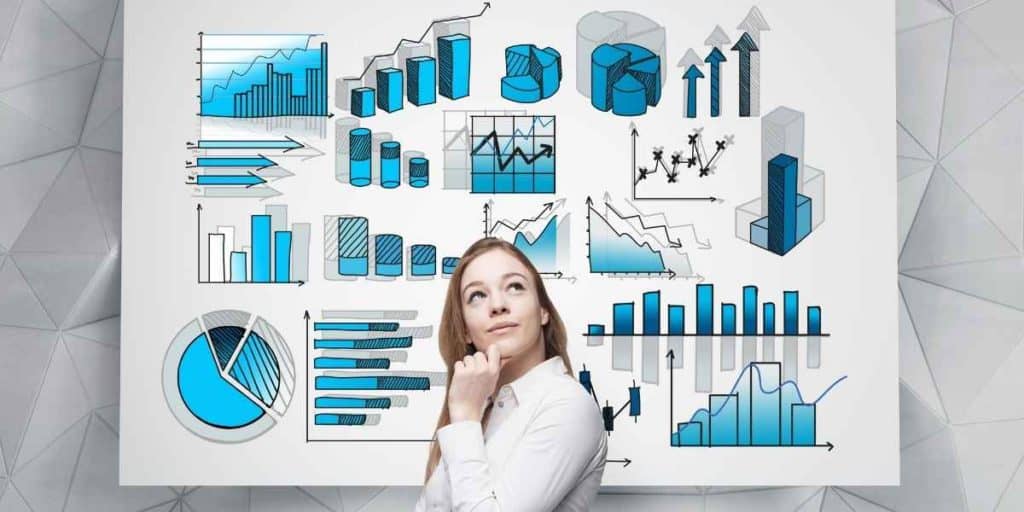Data science has recently risen to one of the most employable fields in modern times. With the big tech companies beating index funds in stock performance and big data getting bigger by the day, it seems like the industry is as future-proof as any. If you are looking to make a transition in your career or start a new one, this may tempt you to acquire the skills you need to pursue data science as a profession.
The golden skills that make a great data scientist are statistics, programming, machine learning, and data visualization. While there are still many other skills you need to master before being declared the master of this field, these are the non-negotiable ones that will help you get started.
In this article, you will learn more about the aforementioned skills and other skills that will help you become a top-quality data scientist. Each skill will be broken down in relation to its importance within modern data science jobs, so you can decide for yourself how urgently you need to acquire the specific skill and how you should prioritize it.
Important Sidenote: We interviewed numerous data science professionals (data scientists, hiring managers, recruiters – you name it) and identified 6 proven steps to follow for becoming a data scientist. Read my article: ‘6 Proven Steps To Becoming a Data Scientist [Complete Guide] for in-depth findings and recommendations! – This is perhaps the most comprehensive article on the subject you will find on the internet!

Table of Contents
Linear Algebra and Matrices
A deep dive into this subject would take up as much space as the rest of the article, and that is exactly how important the fundamentals of linear algebra are for a data scientist. A lot of data science leverages the power of machine learning and data-sorting algorithms.
However, the key question is, how does a program sort image into readable data? In ones and zeros. That means any visual data mapped into a readable space is likely done in the form of a matrix with a linear algebra equivalent.
To simplify the point, matrices and linear algebra make up the vocabulary and the grammar upon which machine learning rests. While most programming for machine learning happens in programming languages, without a solid understanding of how images get converted to readable data, you will not get very far.
Statistics
As a data scientist, you will be working with samples of data to project consequences and implications. To do this accurately, you will need a solid grasp of statistics.
Suppose that you are working on studying consumer behavior for a corporation. With the right grasp of statistics, you will be able to learn more about average consumer behavior, how buying patterns change in relation to other factors towards the extreme ends of your data set, and, more importantly, how you can glean patterns across hundreds of thousands of pieces of data.
You may be familiar with the term statistics in a traditional sense. Those are descriptive statistics and are made up of mean, median, and range in addition to variance and deviance. However, as a data scientist, you will need to go beyond the classic statistics to collect and organize your statistical data with exploratory analysis. It is also important that you account for what makes statistical data unreliable.
Books like How to Lie With Statistics show that one can manipulate statistics to paint any narrative they see fit. While that might be a great skill for PR and marketing experts, as a data scientist, you will leverage your knowledge to reduce the possibility of inaccurate conclusions being derived from statistics. For this, you will need to understand outliers, skewness, and cumulative distribution function.
Data Ingestion
While understanding statistics is crucial in bringing you closer to extracting truth from data, you need to import data before you can begin analyzing or manipulating it.
If you are building a data science team and infrastructure from the ground up, data ingestion may seem like such an obvious step that you may overlook the importance of the skill altogether. That is because you will design your data inputs to be easy enough to be important.
Unfortunately, data scientists don’t work alone within the infrastructures they have set up. The chances are, you will be hired in a position where the data input and data points will be predetermined. Employers want to know that you are able to conduct data ingestion regardless of the level of complication of a data recording structure.
Apache Sqoop (named after scooping data) and Apache Flume are some of the tools usually used in the data science profession. That said, data ingestion is nowhere near standardized in the industry. You will need to be a quick learner as you may inherit a date ingestion structure that relies on a completely different program.
Make sure you look for the following functions in any data ingestion software you find yourself working with.
- Import: This is the option that allows you to import data. Often by clicking on it, you find out the type of data can import.
- Export/Transfer: This function helps you produce an output that can be fed into another program or directly included in your reports.
- Processing: This can vary from program to program. For instance, Sqoop processes data so that it is ready for Hadoop. This processing is different from Kafka. While you may not need to know the exact processing method, as long as you know what the data becomes after being run through the ingestion program, you will have a functional understanding of the program.

Data Munging
The nature of data science remains experimental. One of the consequences of this is the inclusion of unrelated data in the overall dataset. Managing data is the skill of cleaning up data mainly by removing the unrelated and unimportant bits so that what remains is legible and can be understood by a generally knowledgeable audience.
For this, you have to keep track of hypothetical relations between different data points. That way, you can eliminate random data that do not impact the focus of your research. Think of munging as sculpting, with the only difference being that a sculptor can shape the block into anything he desires while the data scientist is bound to retain the key information conveyed by the data.
Another way to think about munging data is like molding rough blocks to fit a specific slot. The slot is usually a data processing software, and you mung data until it is input-ready. While data munging is often used as a term for deleting pieces of data, it broadly applies to reorganizing and categorizing the data as well. As long as you are making the data input-ready without further ingestion, you are munging it.
Data Visualization
When you hear about data, chances are, you think about bar charts, graphs, and images. That is because most data consumed by the general audience is a visualization of the data and not the raw data.
As a data scientist, you will be reporting many of your findings in the form of similar charts or graphs. Whether for a grant you are pitching for as an academic data scientist or a deck you are preparing for your employer’s shareholders, you will need to make data as simple to understand as possible using data visualization.
While bar charts and graphs are some of the traditional modes of visualizing data, this specific domain has advanced to new avenues. For instance, there is heat mapping software that can let a web-owner know which areas users are clicking more on. With the right split-tests, you can visualize whether people click on certain articles based on their position or their content.
As new technologies are introduced, you will find new methods of data visualization. The fundamentals that you must hold on to regardless of technology and the visual are that you are supposed to make the data understandable. Any visual tool that helps you in this will fall under data visualization.
Data Integration
You may have conducted surveys in school or university or participated in one for a free coupon. That is the simplest way of collecting data because a single source collects the data using a singular methodology. Now imagine that instead of asking you for your age on the survey, the survey conductor received a copy of your birth certificate.
Also, instead of asking about your household income, he got a copy of your bank records. What would be the next step? He would have to extract your age and income from two different sources and include it on the same survey as your answers. That is, data integration on the basic level.
Because data collection tools have become smart and the number of data points has increased exponentially, it has become crucial for data scientists to understand data integration. There are two types of integrations that you will find yourself dealing with, most often.
- Data consolidation: This is where you add information from different data points into a unified view.
- Cross-checking data: While not popularized as an integration, you will often conduct cross-checks at the integration stage. Two or more data points may be collecting the same information, and you will make sure of the data’s accuracy before placing it in a unified view with duplicates either deleted or collapsed.

Programming
This aspect of data science could be expanded into a list by itself because of how broad the field is. Programming is crucial to a data scientist’s success because it allows one to write code that can perform data science functions.
As you may know, data becomes more reliable as it gets big until it reaches the point of diminishing returns. Programming allows you to scale your data collection, integration, and visualization to an optimal degree.
Because of how lucrative the field is, more and more big-data processing programs are coming to the market; this is great because you will not need to create programs from scratch. However, since the programs are not meant for the general public’s consumption, their interfaces aren’t simplified too much.
You will need to master at least two programming languages to leverage the full capabilities of platforms available to data science. Since Python is one of the most commonly used programming languages in the space, it is essential that you start by learning to write simple commands in Python. If you want to increase your appeal to organizations and employers, you can also become proficient in R.
Data Manipulation
Though the term manipulation may bring up negative connotations of falsehood, data manipulation within the nomenclature of data science has to do with making data easier to learn. In other words, the term “income per household” is an invention of data manipulation.
By making data fit this descriptor, you are manipulating raw data to be easily understandable by an audience that is not made up of data science professionals. Data manipulation is often a foundational skill upon which data communication is conducted.
Data manipulation is the equivalent for munging but for a human audience. Of course, you have learned by now that data sets that data scientists deal with are often too large to be processed without the help of computers. You will not be manipulating data one byte at a time. In fact, there is an entire programming language called Data Manipulation Language (DML) that helps you manipulate large sets of data for better accessibility.
Binary Tree
A binary tree helps organize the data in a way that is easy to search. It can also help machine learning programs make decisions regarding data collection, manipulation, and presentation. It is important to understand binary trees because the skill essentially allows you to become efficient at storing data and effective at producing machine learning algorithms.
Machine Learning
As a data scientist, you will find yourself racing against time. Take, for instance, the fact that over 300,000 hours of video content is uploaded to YouTube every hour. As a human, it would be impossible for you to go through all of this content because of the backlog it would create.
By the time you have 299,999 hours of untreated data, an additional 300,000 hours of data would have been uploaded to the platform. The organization, therefore, uses machine learning algorithms that sift through content to flag nudity, understand keywords, and transcribe information.
As a data scientist, anytime you find yourself doing a task that is too repetitive for you yet novel enough for traditional programs, you have stumbled across the opportunity to employ machine learning to scale your data processing.

Deep Learning
Deep learning deserves a different placement because while still a part of machine learning, it serves a different purpose. As explained with the example of YouTube, machine learning tackles the challenge of having too much data that needs to be processed in a smaller timespan.
Deep learning may tackle that problem but is mostly concerned with educating programs at the right depth to replace humans. As a data scientist, deep learning mastery allows you to produce the output of a team of hundreds of data science professionals.
The term is synonymous with the buzz word Artificial Intelligence because it allows computer processors to mimic a human student. Many jobs are in jeopardy because of automation that comes from deep learning. Fortunately for data scientists, deep learning doesn’t really replace the need for someone to create deep learning algorithms.
Big Data
When we talk about surveys and questionnaires, we are talking about sample sizes so small that comparatively speaking, the bigger the data, the better the result.
However, if you get a data set to be big enough, you can draw any conclusion. Just like a randomizing algorithm running across an infinite period would eventually spit out a Shakespeare classic, an algorithm looking for specific connections running through a large enough data set will find it.
A famous example of this was the Bible code. Tasked with finding predictions of key events like 9/11—the algorithm went to work and did indeed find the prediction encrypted within the bible.
The Torah code became a popular hit among believers before Brendan McKay tasked a similar code to find “There are codes in Moby Dick.” Not only did he find that in the bible, but he also “found” a code in The Moby Dick claiming that there was no code in the bible.
This proves that “big data” is not a straightforward scaling operation and requires a completely different handling method that controls against the tendency to remove false correlations and connections between unrelated data. While machine learning cannot come up with these error-correcting instructions spontaneously, they can course-correct within parameters set by humans.
As more and more organizations rely on big data, you have to master handling larger data sets, know how to limit your samples, and what error-correcting measures to introduce into your data processing. If you want to work at Google, Facebook, or any social media or search-service company, you need to be proficient with big data as a prerequisite.
Problem-Solving
Humans are solution-oriented beings, and all innovations championed by our species are a result of solving problems. Data scientists operate on the frontiers of this endeavor as they not only set data collection operations to come up with a solution but often go on problem-finding missions with data processing.
As a data scientist, you will need to be able to view data through a solution-seeking lens. Below are some of the examples of how you may need problem-solving on a day to day basis.
Data Collection as a Problem
Data collection infrastructure may be in place at the organization you join, but it is possible that you are informed of the data required by the company, but you have to find and recommend methods of collecting and ingesting the data.
Finding Problems as a Solution
Ironically, you may be tasked with a mission where your solution is to find a problem. In a lower-stakes mission, you may be tasked to figure out why customers abandon their shopping carts when shopping online. A very simplistic approach would be to send out a survey.
A data scientist with adequate problem-solving acumen would probably heatmap the website and use cookies to monitor the sample’s browsing activity. This would help the scientist understand what factors lead to cart abandonment.
Creating Programs to Solve Problems
We discussed machine learning and deep learning. It is impossible to create an effective machine learning program without giving it a task. Therefore, developing a machine learning algorithm is an exercise in problem-solving.
Data Visualization as Problem-Solving
When you are mapping data into a visual medium, you are dealing with the problem that your data is too complicated to make the point you wish to communicate. As you visualize the data, you are solving this problem, and if you have a solid understanding of problem-solving, you are more likely to visualize the data legibly.

Independent Learning
While you need to learn how to use data science tools, these tools can and will change. What you need to master is the ability to teach yourself new programs, programming languages, and software use. As the field changes at a rapid pace, you should be able to adapt and keep your knowledge up to date.
If you are promoted to a senior position where you handle the use of big data to advocate for solutions, chances are, you may be in unchartered territory. You will need to not only learn new skills but may have to borrow from other tech disciplines to provide a basic outline for your team or programs to follow.
By now, it must be clear that in addition to acquiring skills in managing specific tools that are currently popular, you will need to master the meta-skill of acquiring new skills. One way to master independent learning within the software and programming space is to learn how to use unrelated software.
While it is possible that programs that are rarely used by data scientists may come in handy (like Photoshop in parts of data visualization), the key is to become good at getting the hang of a program by either watching online tutorials, reading documentation, or just trying your hand at the interface. The method of learning you should adopt is the one that suits you.
If you are an experiential learner, you should start trying your hand at different software. As time passes, you will start to get familiar with newer software much more quickly.
On the other hand, if you are a visual learner, you can invest your time watching video tutorials for programs that are not related to data science. As long as you can get a functional understanding of a program in a small amount of time, you are improving as an independent learner.
Communication Skills
While this is not exactly the dealmaker, it is important enough to deserve a mention on this list. As a data scientist, a large part of your work is solving problems, but the other aspect is communicating your findings. Just like munging and integration simplify the data for different programs and documents, your communication skills help make the data simple enough for your audience.
You will need two types of communication skills as a data scientist.
- Written communication: Any policy advice you present will almost entirely rely on written communication aside from the visual data included for reference. Most of your findings will be reported in a written format unless you prepare a deck for your employer. The deck you prepare will be mostly visual but will still include summarized elements that are written.
- Verbal communication: This is a skill you need if you will work in an environment with other people around you. Data scientists are rarely secluded and often work in teams. Verbal communication happens in an intra-group as well as inter-group capacities, and you will need to communicate your needs appropriately.
How you communicate also depends on who your audience is. Depending on who you work for, this might change. Most data scientists deal with the following audiences.
- Government entities/Shareholders: These are lumped together because, based on your organization’s nature, you are using (often written) communication to communicate your findings to a group of people who have a stake in the information you bring to them.
- The general public: Senior data scientists often have the additional responsibility of creating deliverables that are communicated to the general audience of a corporation. While this goes through several layers of PR and marketing polish jobs, the underlying data must be communicated clearly enough to internal departments that the message sent to the public is not distorted.
- Colleagues: This communication happens mostly in a verbal medium and sometimes over email. Not a lot of this has to do with the entirety of the data. However, if you have direct reports or are directly reporting to someone, you will need a solid understanding of basic communication to communicate your findings, concerns, and needs clearly.
Author’s Recommendations: Top Data Science Resources To Consider
Before concluding this article, I wanted to share few top data science resources that I have personally vetted for you. I am confident that you can greatly benefit in your data science journey by considering one or more of these resources.
- DataCamp: If you are a beginner focused towards building the foundational skills in data science, there is no better platform than DataCamp. Under one membership umbrella, DataCamp gives you access to 335+ data science courses. There is absolutely no other platform that comes anywhere close to this. Hence, if building foundational data science skills is your goal: Click Here to Sign Up For DataCamp Today!
- IBM Data Science Professional Certificate: If you are looking for a data science credential that has strong industry recognition but does not involve too heavy of an effort: Click Here To Enroll Into The IBM Data Science Professional Certificate Program Today! (To learn more: Check out my full review of this certificate program here)
- MITx MicroMasters Program in Data Science: If you are at a more advanced stage in your data science journey and looking to take your skills to the next level, there is no Non-Degree program better than MIT MicroMasters. Click Here To Enroll Into The MIT MicroMasters Program Today! (To learn more: Check out my full review of the MIT MicroMasters program here)
- Roadmap To Becoming a Data Scientist: If you have decided to become a data science professional but not fully sure how to get started: read my article – 6 Proven Ways To Becoming a Data Scientist. In this article, I share my findings from interviewing 100+ data science professionals at top companies (including – Google, Meta, Amazon, etc.) and give you a full roadmap to becoming a data scientist.
Conclusion
Data science is an ever-green field that only expands in terms of job opportunities and compensation. If you are looking to get a job in the field, make sure to follow these steps to have the right skills:
- Understand the fundamentals of data science.
- Learn the right programming languages.
- Get a solid grasp of data visualization and processing tools
- Understand machine learning and deep learning.
Once you have mastered the skills mentioned in this article, you will be ready for a career in data science.
BEFORE YOU GO: Don’t forget to check out my latest article – 6 Proven Steps To Becoming a Data Scientist [Complete Guide]. We interviewed numerous data science professionals (data scientists, hiring managers, recruiters – you name it) and created this comprehensive guide to help you land that perfect data science job.
Affiliate Disclosure: We participate in several affiliate programs and may be compensated if you make a purchase using our referral link, at no additional cost to you. You can, however, trust the integrity of our recommendation. Affiliate programs exist even for products that we are not recommending. We only choose to recommend you the products that we actually believe in.
Recent Posts
Data science has been a buzzword in recent years, and with the rapid advancements in artificial intelligence (AI) technologies, many wonder if data science as a field will be replaced by AI. As you...
In the world of technology, there's always something new and exciting grabbing our attention. Data science and analytics, in particular, have exploded onto the scene, with many professionals flocking...
